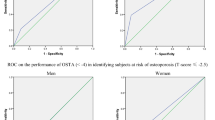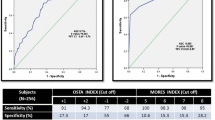Abstract
Summary
This cross-sectional study done on 5356 postmenopausal women showed that OSTA may be used as a reliable screening tool for osteoporosis across different regions of India, a country known for its ethno-linguistic, cultural, and genetic diversity.
Background
The gold standard for diagnosing osteoporosis is DXA (dual-energy X-ray absorptiometry) scan, and this is not widely available across India. OSTA (Osteoporosis Self-Assessment Tool for Asians) score predicts risk of osteoporosis and can be used as reference tool for DXA. At a cutoff of ≤ + 1, OSTA predicted femoral neck osteoporosis with a sensitivity of 88% in a previous study among south Indian postmenopausal women. This study was done to validate the OSTA score in postmenopausal women across India.
Methodology
A cross-sectional study in 5356 postmenopausal women from four regions of India namely south, east, north, and west. Bone mineral density (BMD) and trabecular bone score (TBS) were assessed by DXA. The performance of OSTA in predicting BMD and TBS was assessed using ROC curve.
Results
The mean (SD) age was 61.6 (7.6) years. The performance of OSTA in predicting osteoporosis was fair (P < 0.001) with an AUC of 0.727 (95% CI 0.705–0.749) in the south, 0.693 (95% CI 0.664–0.723) in east India, 0.730 (95% CI 0.700–0.759) in the north, and 0.703 (95% CI 0.672–0.735) in the western region. At a cut-off below + 1.0, sensitivity was 76–84% and specificity was 45–53% in diagnosing osteoporosis at any site. In predicting degraded microarchitecture, the AUC was 0.500–0.600.
Conclusion
OSTA may be reliably used as a screening tool for women at high risk of osteoporosis across India and may circumvent the limited availability of DXA scanners across the country.



Similar content being viewed by others
References
Paul TV, Thomas N, Seshadri MS, Oommen R, Jose A, Mahendri NV (2008) Prevalence of osteoporosis in ambulatory postmenopausal women from a semiurban region in Southern India: relationship to calcium nutrition and vitamin D status. Endocr Pract 14(6):665–671
Malhotra N, Mithal A (2008) Osteoporosis in Indians. Ind J Med Res 127(3):263–268
Marwaha RK, Tandon N, Garg MK, Kanwar R, Narang A, Sastry A et al (2011) Bone health in healthy Indian population aged 50 years and above. Osteoporos Int 22(11):2829–2836
Binu AJ, Cherian KE, Kapoor N, Jebasingh FK, Asha HS, Paul TV (2019) Bone health after fifth decade in rural ambulatory south Indian postmenopausal women. Ind J Community Med 44(3):205–208
Mithal A, Bansal B, Kyer CS, Ebeling P (2014) The Asia-Pacific regional audit-epidemiology, costs, and burden of osteoporosis in India 2013: a report of International Osteoporosis Foundation. Indian J Endocrinol Metab 18(4):449–454
Shatrugna et al. - Population based reference standards of Peak Bone.pdf [Internet]. [cited 2022 Feb 23]. Available from: https://main.icmr.nic.in/sites/default/files/reports/ICMR_Tech_Report_BMDRefStds2010.pdf
Shetty S, Kapoor N, Naik D, Asha HS, Thomas N, Paul TV (2014) The impact of the Hologic vs the ICMR database in diagnosis of osteoporosis among South Indian subjects. Clin Endocrinol (Oxf) 81(4):519–522
Cherian KE, Kapoor N, Asha HS, Thomas N, Paul TV (2018) Influence of different reference databases on categorization of bone mineral density: a study on rural postmenopausal women from Southern India. Ind J Endocrinol Metab 22(5):579–583
Paul TV, Selvan SA, Asha HS, Thomas N, Venkatesh K, Oommen AT et al (2015) Hypovitaminosis D and other risk factors of femoral neck fracture in South Indian postmenopausal women: a pilot study. J Clin Diagn Res 9(6):OC19-22
Cooper C (1997) The crippling consequences of fractures and their impact on quality of life. Am J Med 103(2A):S12–S19
Rubin KH, Friis-Holmberg T, Hermann AP, Abrahamsen B, Brixen K (2013) Risk assessment tools to identify women with increased risk of osteoporotic fracture: complexity or simplicity? A systematic review. J Bone Miner Res 28(8):1701–1717
Koh LK, Sedrine WB, Torralba TP, Kung A, Fujiwara S, Chan SP et al (2001) A simple tool to identify asian women at increased risk of osteoporosis. Osteoporos Int 12(8):699–705
Cherian KE, Kapoor N, Shetty S, Naik D, Thomas N, Paul TV (2018) Evaluation of different screening tools for predicting femoral neck osteoporosis in rural South Indian postmenopausal women. J Clin Densitom 21(1):119–124
Indian Genome Variation Consortium (2005) The Indian Genome Variation database (IGVdb): a project overview. Hum Genet 118(1):1–11
Singh JC, Kekre NS (2009) CMC Vellore—in the service of our nation for more than a century. Ind J Surg 71(5):284–287
Binu AJ, Cherian KE, Kapoor N, Thomas N, Paul TV (2018) Referral pattern for DXA scanning in a tertiary care centre from southern India. Arch Osteoporos 13(1):133
Schousboe JT, Shepherd JA, Bilezikian JP, Baim S (2013) Executive summary of the 2013 International Society for Clinical Densitometry Position Development Conference on bone densitometry. J Clin Densitom 16(4):455–466
Shevroja E, Lamy O, Kohlmeier L, Koromani F, Rivadeneira F, Hans D (2017) Use of trabecular bone score (TBS) as a complementary approach to dual-energy X-ray absorptiometry (DXA) for fracture risk assessment in clinical practice. J Clin Densitom 20(3):334–345
Rajan R, Cherian KE, Kapoor N, Paul TV (2020) Trabecular bone score—an emerging tool in the management of osteoporosis. Ind J Endocrinol Metab 24(3):237–243
Muslim D, Mohd E, Sallehudin A, TengkuMuzaffar T, Ezane A (2012) Performance of Osteoporosis Self-Assessment Tool for Asian (OSTA) for primary osteoporosis in post-menopausal Malay women. Malays Orthop J 6(1):35–39
Zha XY, Hu Y, Pang XN, Chang GL, Li L (2015) Diagnostic value of osteoporosis self-assessment tool for Asians (OSTA) and quantitative bone ultrasound (QUS) in detecting high-risk populations for osteoporosis among elderly Chinese men. J Bone Miner Metab 33(2):230–238
Yang NP, Lin T, Wang CS, Chou P (2004) Correlation of osteoporosis screening by quantitative ultrasound of calcaneus and Osteoporosis Self-Assessment Tool for Asians in Taiwanese. J Formos Med Assoc 103(2):130–136
Chaovisitsaree S, Namwongpromnong S, Morakote N, Suntornlimsiri N, Piyamongkol W (2007) Comparison of osteoporosis self assessment tool for standard assessment in Menopause Clinic Chiang Mai. J Med Assoc Thai 90(3):420–5
Fransiska Y, Tiksnadi B, Chaidir R, Ismiarto YD (2012) The male osteoporosis risk estimation score and the osteoporosis self-assessment screening tool for Indonesian men. J Orthop Surg (Hong Kong) 20(2):205–208
Machado P, Coutinho M, da Silva JAP (2010) Selecting men for bone densitometry: performance of osteoporosis risk assessment tools in Portuguese men. Osteoporos Int 21(6):977–83
Bhat KA, Kakaji M, Awasthi A, Kumar K, Mishra K, Shukla M et al (2017) Utility of Osteoporosis Self-Assessment Tool as a screening tool for predicting osteoporosis in Indian men. J Clin Densitom 20(2):160–163
Satyaraddi A, Shetty S, Kapoor N, Cherian KE, Naik D, Thomas N et al (2017) Performance of risk assessment tools for predicting osteoporosis in south Indian rural elderly men. Arch Osteoporos 12(1):35
Cherian KE, Kapoor N, Meeta M, Paul TV (2021) Screening Tools for osteoporosis in India: where do we place them in current clinical care? J Midlife Health 12(4):257–262
Author information
Authors and Affiliations
Corresponding author
Ethics declarations
Conflict of interest
None.
Additional information
Publisher's note
Springer Nature remains neutral with regard to jurisdictional claims in published maps and institutional affiliations.
Rights and permissions
Springer Nature or its licensor holds exclusive rights to this article under a publishing agreement with the author(s) or other rightsholder(s); author self-archiving of the accepted manuscript version of this article is solely governed by the terms of such publishing agreement and applicable law.
About this article
Cite this article
Agarwal, K., Cherian, K.E., Kapoor, N. et al. OSTA as a screening tool to predict osteoporosis in Indian postmenopausal women — a nationwide study. Arch Osteoporos 17, 121 (2022). https://doi.org/10.1007/s11657-022-01159-w
Received:
Accepted:
Published:
DOI: https://doi.org/10.1007/s11657-022-01159-w




